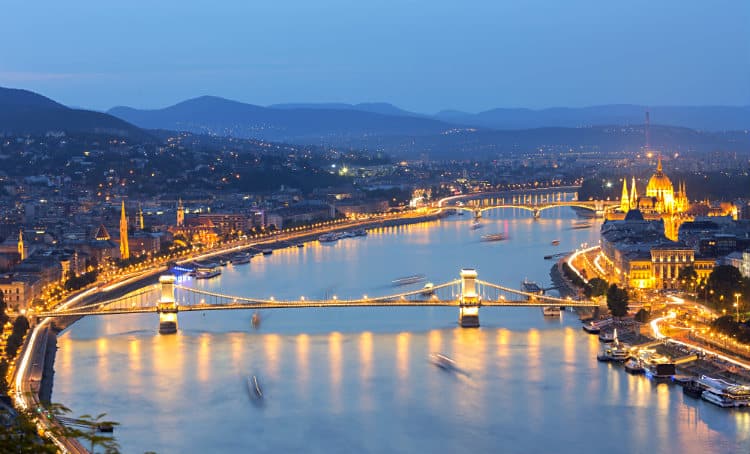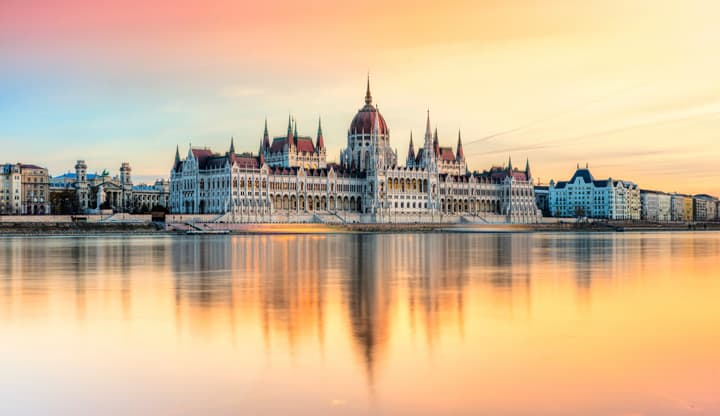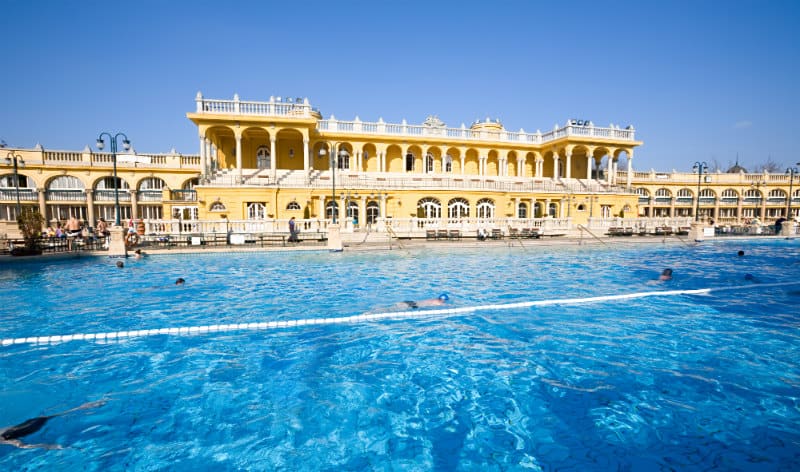
Gay Budapest · City Guide
Visiting Budapest? Then our gay Budapest city guide is for you.
Budapest
Budapest is the capital and largest city in Hungary - a member state of the European Union. Located in the northwest of the country, close to the borders of Austria and Slovakia, Budapest is home to nearly 3 million people in it's urban area.
Officially established in 1873 after the merging of Buda and Pest, the history of Budapest is as fascinating as it is turbulent. When admiring the city's many grand art-nouveau buildings it's easy to forget the city was heavily damaged during the second world war and endured a repressive communist regime in the 50's.
Nowadays, Budapest is a bustling cultural and commercial hub with a whole host of things to attract the 4.4 million tourists that visit the city year in year out.
Hotels, restaurants, cafes and bars are comparatively cheap and good value compared with other European capitals.
Gay Rights in Hungary
Hungary decriminalised homosexuality in 1961 but it wasn't until 2002 that 14 was established as the equal age of consent for both heterosexuals and homosexuals.
Sexuality based discrimination is outlawed by Hungarian law. However, adoption is not available for same-sex couples.
Registered partnerships have offered the majority of legal protections to same-sex couples since 2009 however amendments to the constitution that would allow for gay marriage have been rejected by parliament as recently as 2015.
Gay Scene
Budapest is for the most-part an open-minded city. However, it is advised to keep overt displays of public affection to a minimum. Like a lot of the ex-communist states, Hungary is lagging a little behind in comparison to countries like Spain, France or Germany.
There is no established gay district in Budapest. The majority of gay venues are situated on the Pest side of the Danube. There is a selection of Gay Bars, Gay Dance Clubs, Gay Cruise Clubs and Gay Saunas, although the scene is much smaller than in other European capitals.
Budapest is known for it's collection thermal bath-houses. These are mainstream locations and it is advised to treat them as unsuitable cruising locations.

Getting to Budapest
By air
Budapest Ferenc Liszt International Airport (BUD) is the largest of Hungary's four airports and is only 16 km from the centre of Budapest.
The cheapest way to get into the centre is by public transport. From 4am to 11pm the bus 200E runs from Terminal 2 to Kőbánya-Kispest terminal which connects to the Metro system. Night bus 900 runs between 1am and 4am. Tickets cost 350 HUF (more on the bus).
Taxi's are readily available at the airport. Exit the airport and find the Főtaxi taxi booth. State your destination (e.g. your hotel) and the dispatcher will print off a slip of paper with a taxi number and estimated fare. Simply look for your taxi in the rank and show the slip of paper to your driver. The actual fare is that shown on the meter. Prices are typically around the 6500 HUF mark but can vary depending on traffic.
By train
Budapest is an important European rail hub with many major coming to the city. From Budapest's Keleti station you can travel to central and Eastern Europe and a few locations in the Balkan states.
Getting around Budapest
Budapest is comprised of two historic cities. "Buda" is the hilly side on the west side of the Danube. The relatively flat "Pest" is on the east side of the river.
Walking
Most tourist sights in "Pest" are within walking distance of each other. On a sunny day, this is the best way to explore the city.
The main sites on the Buda side (Budapest Castle and Fishermans Bastion) are at the top of a step hill. Walk up or take the Funicular Railway (expect long queues - a better option is to take a taxi from your hotel).
Metro, tram and bus
Established in 1896, Budapest has the second oldest underground railway system in the world. The city also has a good tram and bus system.
Single tickets cost 350 HUF and day tickets start from 1650 HUF. You need to buy your tickets before boarding as ticket inspectors sometimes work undercover. Trains run from around 4.30am - 11.30pm. Some tram lines run later and there are night bus services.
Taxi
Taxi's are cheap compared with other capital cities in Europe. Prices start from 480 HUF (about $1.75 USD). Fares are metered.
Do NOT use taxis marked as "Freelancers" who are not associated with the major taxi companies (i.e. FoTaxi, City Taxi, Budapest Taxi). The Freelancers are notorious for overcharging, Download an app for them and you will be all set.
 Széchenyi Baths
Széchenyi Baths
Where to Stay in Budapest
For our list of recommended hotels in Budapest, please check the Gay Budapest Hotels page.
Things to See & Do
Budapest Castle Museum and Hungarian National Gallery - located in the majestic palace overlooking the Danube. Views of the city from the terraces are excellent.
St Stephen's Basilica - beautiful neo-classical cathedral in heart of city. The weekly one hour organ concerts are excellent.
Danube Promenade - walk from from the Parliament Building, past the Chain Bridge to Elisabeth suspension bridge.
Gellert and Széchenyi Baths - Budapest is fortunate enough to be built atop a series of thermal springs which has resulted in a number of thermal baths being built in the city. The two listed here are the grandest and most popular.
The Hungarian Parliament - grand and imposing building on the banks of the Danube. Guided 45 minute tours are available in various languages. Advance booking (online) strongly recommended as tours are often sold-out.
Hungarian National Museum - well organised museum that provides a fascinating insight into the history of the country, from 400,000 BC to the fall of communism.
Fisherman's Bastion - viewing terrace on the Buda side of the river overlooking Pest and St Margaret Island. A romantic and fairy tale setting for a stroll.
Central Synagogue - the largest synagogue in Europe. It's known for it's striking architecture and memorial to Hungarian Jews killed in the Holocaust.
Heroes' Square - open square with impressive monuments. There are two good art museums either side of it.
Hungarian State Opera - ornately decorated neo-renaissance concert hall on Andrássy Avenue. There are daily guided tours but we would recommend catching a show there to truly experience its grandeur.
House of Terror - museum highlighting the atrocities committed during the Nazi and communist periods of Budapest recent history. Arrive early or expect a long queue to get in and a second queue to descend by lift to the basement cells.
When to Visit
It's best to plan a visit to Budapest in the spring or early summer (April-May-June) and fall (September-November) as the weather is pleasant and there aren't too many tourists.
Winters, like in much of Central Europe, are a cold but the snow does make Budapest look even more magical.
Visa
Hungary is within the Schengen visa area. If travelling from outside Europe, you should check to see if you require a Schengen visa.
Money
The currency in Hungary is the Forint (HUF). Some stores, restaurants and hotels accept payments in euros but the exchange rate may not be very good.
Currency booths in Budapest city center offer pretty good exchange rates for Euro's, US dollars and Pound sterling. You are likely to get a better deal here than abroad. Currency booths at the airport are much less competitive.
Cash dispensers are widely available. Credit and debit cards are widely accepted using chip and pin.
Tipping
Typically a 12 or 13% service charge will be added to your bill in restaurants and cafes. No further tip is expected.
Taxi drivers will expect a tip. Our experience was that they would simply withhold change unless asked!
Join the Travel Gay Newsletter
Have we got something wrong?
Are we missing a new venue or has a business closed? Or has something changed and we have not yet updated our pages? Please use this form to let us know. We really appreciate your feedback.